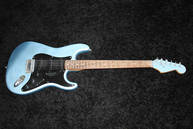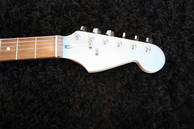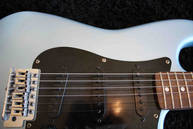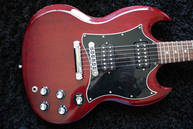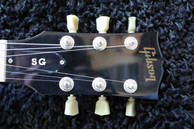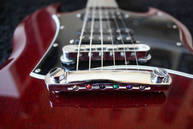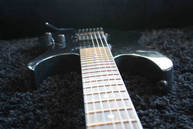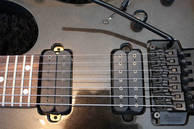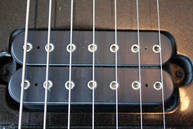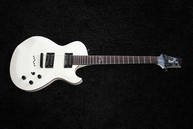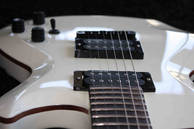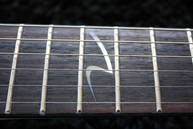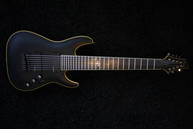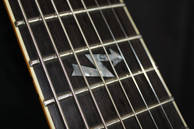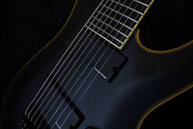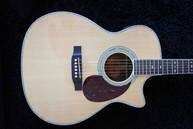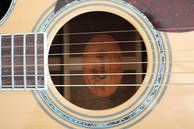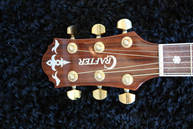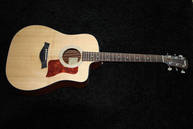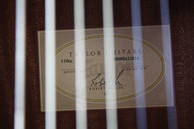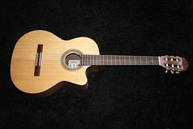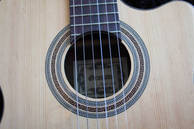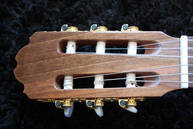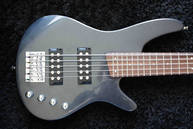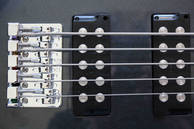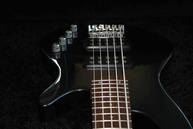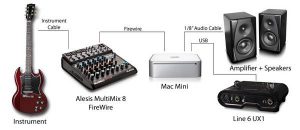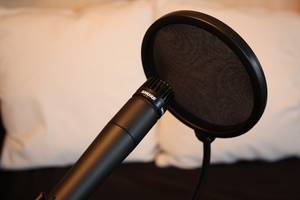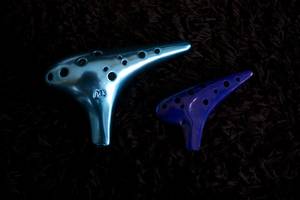Here you will find a description of the guitars, effects, strings, picks and recording equipment that I use for my covers. If you want more details on the specifications of the guitars or if you want to know how they sound you can watch my gear video on YouTube or in the video section of this website.

































Guitars
Squier Bullet Strat
The strat was the first guitar that I bought back in 2004. I repainted it several times and made some modifications to make it sound and play better. I barely use it anymore though because it desperately needs a fret job, but it sounds really nice. It was a very good guitar for me to learn to play on as well as trying new things such as changing intonation, action and adjusting the truss rod. I would definitely recommend this guitar to starting players.
Gibson SG Special
The Gibson was the second guitar that I bought. After playing on the Squier for a while I figured that it was time to buy a quality guitar. I have always liked the body shape of the SG and the way it sounds. Also I really liked the thought of owning an actual Gibson and the SG special was one of the most affordable guitars of that brand at the time. So on my sixteenth birthday I got the guitar with a little help from my parents. It plays amazingly well and I think it is the best sounding guitar of all the ones that I own.
Ibanez RG7420
When I really got into the more heavy and progressive styles I noticed that a lot of players like John Petrucci use seven string guitars. I became really interested in the possibilities of the extended range and I wanted to buy a seven string guitar. However, seven string guitars were quite rare and expensive out here at the time and I didn’t want to pay over €1,000 for a new guitar. I was lucky to find a really good Ibanez RG on the internet and the guy who owned it was nice enough to sell it to me for a very good price. The seven string noticeably changed the way I play and write music. It’s a very heavy sounding guitar thanks to the Dimarzio Evolution 7 pickup and it plays really smooth, although I’m not a big fan of double locking tremolos.
Cort Z44
When I bought the Cort I was looking for a guitar that I could use for heavy rhythm parts. I needed a guitar that could handle low alternate tunings well but also sounded good clean. The Ibanez didn’t really handle the alternate tunings very well because of the tremolo and all the tuning problems that come with it. However, after playing the guitar for a while at home I liked the clean and the lead tones of the Cort so much that I decided to keep it in standard tuning and use it as one of my main guitars. It has very nice mids, shimmering cleans, sounds really full and is very versatile because of the coil split. Also the building quality is great and overall it’s a great guitar, especially for the money.
Schecter Blackjack ATX C-8
I had been wanting to get an 8-string for quite a long time now but I was never really able to find and afford one. I absolutely love the sound of a seven-string but ever since I started listening to bands like Messhugah and Animals as Leaders I felt the need for a little more low end. Moreover, I also used a drop-A tuning on my Ibanez quite a lot, but tuning down with the Floyd Rose was an absolute nightmare. So the best solution for me was to get a good 8-string and I was immediately attracted to the Schecter Hellraiser because of the mahogany body, set neck construction and active pickups. I decided to try out both the six-string models of the Blackjack and the Hellraiser, since the 8-string versions weren’t available and I came to the conclusion to the conclusion that I liked the Blackjack a lot more because of the Seymour Duncan Blackouts. After a long search I finally managed to find one at a local guitar shop. I was really eager to try it out to see if it met my expectations and if my small hands were big enough for the huge neck. The Schecter even exceeded my expectations in terms of sound and quality and I didn’t have any problems at all with the size of the neck so I decided to buy it. It’s an amazing guitar and I’m confident that it will inspire me to write lots and lots of cool music.
Crafter TC035/N
The Crafter was the first acoustic guitar that I bought. I was looking for a fairly cheap but good quality guitar with a preamp so I could record it. The Crafter really stood out at that price with its nice tone and smooth playability. It does have a very distinct tone however, that I believe not everyone will like. Because of the wood and the type of guitar, a Grand Concert, it has lots of mids but not a lot of high and low tones, so it’s not for everyone. Nevertheless, I like the tone very much, especially for strumming and nice acoustic leads.
Taylor 110CE
After playing the Crafter for about three years I decided I wanted to add another steel-string acoustic to my collection. Again I was looking for a guitar with a pre-amp and a cutaway because of the extended possibilities. Initially I bought a Faith dreadnaught, but the pre-amp was broken so I spent a little more money and switched it for the Taylor. It’s a little more expensive than other guitars with those specifications, but in my opinion it sounds way better. The Taylor has everything that I want from an acoustic guitar: huge sound, plenty of bass and treble and great playability. All in all I’m really happy with it and I think it is really worth spending a little extra money.
Granada 70WF-CWE
I have always really liked the sound and possibilities of the classical guitar, so after I got a little better at playing the acoustic guitar I decided to look for a nice classical guitar. Again I wanted a pre-amp and a cutaway to be able to record the instrument and reach the higher regions on the neck. I was really impressed with the powerful, rich and balanced sound coming from the walnut sides and backs. Also the building quality is quite good for the money and the pre-amp sounds really cool so I’m pretty satisfied with it.
Ibanez SRX 305
I was looking for a versatile bass because this is the only bass that I own and I wanted to be able to record a lot of different styles with it. I also wanted a five-string bass because I needed the low B in order to be able to play along with the seven-string guitar parts. The Ibanez sounded the best and most versatile in the price range. The setup wasn’t very good right from the shelf though, but I made some adjustments to the neck and the bridge and now it plays really well without any string buzz. I’m especially satisfied with the heavy sound that the bass produces because of the two humbucking pickups. When you hit the low B and stuff in the room starts to tremble, that’s when I’m happy. It’s a really good sounding bass for the money and I would definitely recommend it to other guitarists.
Recording gear
I received a lot of questions about the equipment that I record with. It’s one of the most simple recording setups I’ve seen to be honest. All I use is an Alesis MultiMix 8 FireWire and a Mac Mini running GarageBand. The mixer just sends the signal as good and as free from noise as possible to the computer, nothing more. Well, I do use a little bass reduction in the EQ section to prevent the sound from getting too boomy. I don’t use the Line 6 UX1 as an audio interface, but you need to have it connected in order for PodFarm to work. Of course you can also get an iLok key and download POD Farm from Line 6 if you already have an audio interface. POD Farm just needs an external device for authorization.
I always start by plugging my guitar straight into the mixer without any effects. From there the signal goes from the mixer into the FireWire port of the Mac Mini which sends it to GarageBand. All that I have to do is create a nice sound in PodFarm and turn on the right effects. You can see the signal path in the picture above.
If I need to record vocals, mic up my guitar amp or want to record other sounds I use my Shure SM57. I got the Shure because I think it’s a really great sounding and affordable microphone that you can use for pretty much anything. I used it for my specials to record the voice-overs with and I’ve also recorded some ocarina with the SM57, which sounded really great. If you could only get one microphone to use for lots of things, I would definitely recommend the SM57.
If you want more info on how I record you can chec
k out the recording section on this website.
Other gear
Ocarinas
Recently I bought two Ocarinas because I always loved the sound and the looks of the instrument and of course as a Zelda fan I felt that I should have one. As many ocarina owners, I first learned about the instrument from Ocarina of Time. I didn’t quite know what to expect in the sense whether it would be easy to learn or not so I got a plastic 12-hole soprano Ocarina first. They were impossible to get by in the Netherlands so I ordered one online from Songbird Ocarinas.
After playing the plastic soprano for a couple of weeks and when I learned a few songs I decided I wanted a lower sound, because the soprano has a really high pitch and can be extremely loud and sharp. So I ordered a 12-hole Alto C Sweet Potato Ocarina in Blue Chrome, which looks absolutely gorgeous in my opinion. I love the sound and I hope to use it in some of my future covers.
Picks
The picks that I use are Dunlop Tortex Standard 1.14 mm and Dunlop Sharp 1.35 mm. I feel that these picks give me more control and a better, more consistent tone than the Ibanez Grip Wizard picks did. The Dunlop picks offer a really good grip and seem to last pretty long as well.
When I play an acoustic guitar I always use 1.0 millimetre thick nylon picks or 1.0 mm Tortex picks, both from Dunlop. Nylon is a little more flexible than the polyac
etal the Tortex picks are made from. This results in a somewhat brighter sound with more attack and noise from the pick. It depends on what sound I’m going for which picks I use.
Strings
I’ve used various string brands over the years from Ernie Ball and Fender to Gibson, however, I have been using D’Addario Super Light Nickel Roundwound strings for my electric guitars for quite a while now. The main reason for that is that they’re the cheapest strings around plus they last longer than the other string brands that I’ve tried.
The acoustic strings that I use for my Crafter are Martin 80/20 Bronze, again because they are quite cheap and sound great for a long time. I tried using cheap Martin strings for my Taylor but I was really shocked at how much the quality of the tone suffered from it. This showed me that good acoustics need good strings to make a great tone so I went back to Elixir. They may be quite expensive, but I believe that they’re worth it. For my classical acoustic I use D’Addario Classic Normal Tension strings.
The bass strings that I use are Rotosound Roto Bass Medium roundwound strings. I found that by using fretboard lemon oil on the strings before you start playing, you can make bass strings sound almost as good as new so I don’t need to change them very often to get a great bass tone.
Below you can see the different gauges and tunings I use on my guitars.
| Gibson SG Special | .009 – .042 | Standard tuning / Drop D | D’Addario Nickel Roundwound | |
| Cort Z44 | .009 – .042 | Standard tuning / Drop D |
|
|
| Ibanez RG7420 | .009 – .052 | Standard 7-string tuning / Drop A |
|
|
| Squier Bullet Strat | .009 – .042 |
|
D’Addario Nickel Roundwound | |
| Crafter TC035/N | .011 – .052 | Standard tuning | Martin 80/20 Bronze | |
| Taylor 110ce | .013 -.056 |
|
Elixir Medium | |
| Granada 70WF-CWE | .028 – .043 | Standard tuning / Drop D | D’Addario Classic Normal Tension | |
| Ibanez SRX305 | .045 – .130 | Standard 5-string bass tuning | Rotosound Roto Bass Medium |
Cables
I don’t really care what brand of cable I use as long as they’re reliable and sound great. Lately I have been using Planet Waves and Pro Co cables because they are affordable and sound great nonetheless. Having good cables is really important for your sound. You can have a really expensive amp, but you won’t get the best out of it with a crappy cable, so make sure you always buy decent cables.
M-Audio Keystation 49 ES
Beside the guitars that I own I also have an M-Audio Keystation 61 ES to record synthesizer or string parts. You can use the USB port to control all the virtual instruments in GarageBand. Most of the time I program the string parts though, but when I need some chords I play them on the Keystation.



